Intel’s Sandy Bridge i7-2820QM: Upheaval in the Mobile Landscape
by Jarred Walton on January 3, 2011 12:00 AM EST- Posted in
- Laptops
- Intel
- Sandy Bridge
- Compal
Mobile Sandy Bridge Application Performance
We’ll start off with a bang and show application performance, along with media encoding performance comparing Intel’s QuickSync technology with CUDA video encoding. We’ve got a variety of laptops and notebooks in our charts for comparison, including dual-core and quad-core AMD (not their fastest mobile chips, unfortunately), plenty of Arrandale options, and a few Clarksfield notebooks as well. And just for good measure, we’ve included results from a desktop Core i7-920 as a point of comparison. Normally that would be raining on Intel’s parade by showing how previous generation desktop hardware is still quite a bit faster; this time, however… well, I’ll let the charts tell the story.
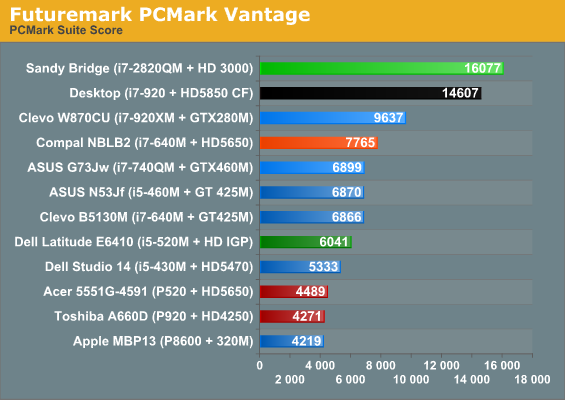
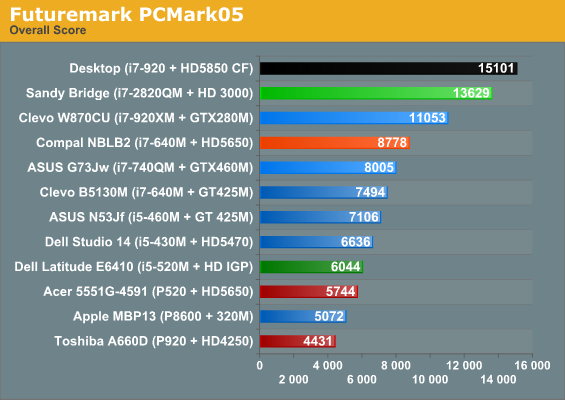
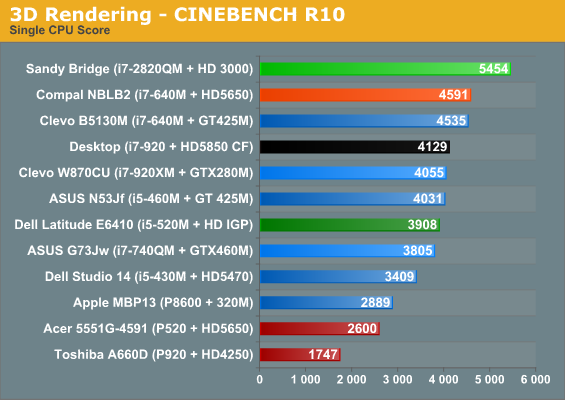
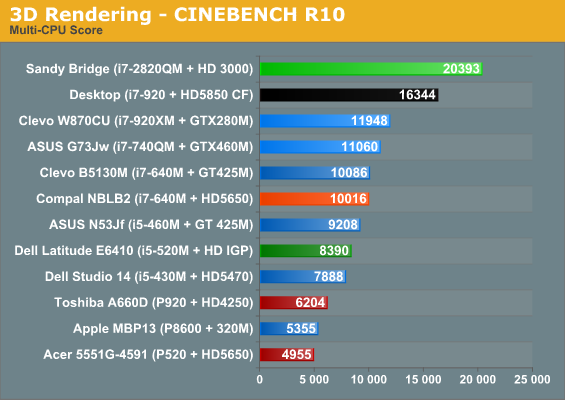
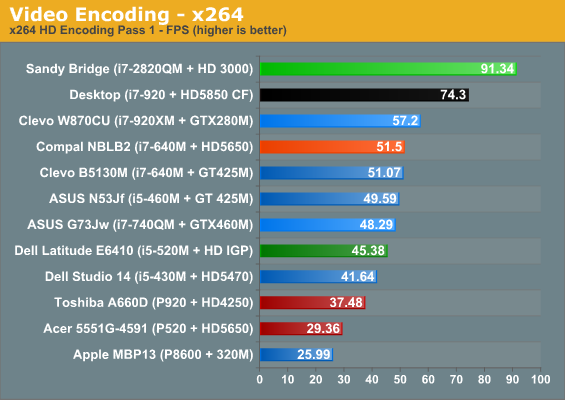

So, is anyone as impressed as I am? Sure, hex-core Gulftown is still the fastest game in town, and the desktop Sandy Bridge chips are obviously going to beat the mobile chips, but check out the scores relative to the i7-920 in my own “for play” system. (Incidentally, my “for work” system is actually running QX6700 still, and it does even worse! But all I do there is type documents and surf the web.) Let’s talk percentages here just to put it all into perspective.
Since PCMark Vantage and 05 are susceptible to heavy SSD influence, we’ll just skip those scores; suffice it to say that Sandy Bridge is no slouch there. Turn to CPU-intensive benchmarks, however, and we can really see the changes. Starting with single-threaded Cinebench, the new i7-2820QM checks in 35% faster than the outgoing i7-920XM, 32% faster than a desktop i7-920, 43% faster than the i7-740QM, and 19% faster than the previous generation’s fastest dual-core part.
Use applications that are thread-friendly and the gap widens even more. In Cinebench SMP, the closest competitor in our charts is the desktop i7-920, and 2820QM maintains a healthy 23% lead—in fact, looking at our desktop reviews, the stock (but with Turbo) 2820QM is roughly equal to an i7-930 overclocked to 3.5GHz. It also leads the i7-920XM by 84%, and an i7-640M by 104% (!). x264 encoding tells a similar story: the second pass is 9% faster than i7-920 desktop, 65% faster than i7-920XM, and twice as fast as i7-640M—and that’s without using the new QuickSync technology! [Whoa, nice segue Batman!]










66 Comments
View All Comments
JarredWalton - Monday, January 3, 2011 - link
True, it's been around a while, but I found it interesting that while performance dropped, it wasn't the "slideshow effect". If the system sat idle, the CPU would start to cool down, so when I fired up a benchmark it would run fast for a little bit. It was very perplexing until I figured out what was happening. First run on MediaEspresso gave me 11s with Quick Sync. Then I ran it again and it was 17s. The next time it was suddenly down to 33s.QChronoD - Monday, January 3, 2011 - link
I'm hoping that someone will annouce something like ASUS's new U36JC that has an i5-2410 at CES. I'd love to be able to go a full day at school without needing to recharge in almost every class (and actaully be able to play minecraft between classes)PlasmaBomb - Monday, January 3, 2011 - link
That should read the GTX465 comes next...
PlasmaBomb - Monday, January 3, 2011 - link
To correct the correction (I was going by the graphs), the graphs for the G73J should read GTX460M (I noticed the reference to the GTX460M in the text later and checked the G73J article).God help us all when it comes to talking/writing about the Sandy Bridge chips themselves, "the i7-2539"...
JarredWalton - Monday, January 3, 2011 - link
Fixed, thanks. I had some good ones in those graphs... G73Jw with 260M and 456M, but no 460M! LOLiwodo - Monday, January 3, 2011 - link
now all that is left are Gfx drivers, i hope intel put 10x more resources at their current Gfx Drivers team.Other then that, i am waiting for Ivy Bridge........
ET - Monday, January 3, 2011 - link
I imagine that a single resolution is the best way to compare different machines, but it would have been nice to see some gaming benchmarks at the native res. 1600x900 is not a whole lot higher than 1366x768 (37% more pixels), so I imagine it's possible to game with low details at that resolution. Many Anandtech articles add such figures into the benchmark tables, and I was really missing them here.JarredWalton - Monday, January 3, 2011 - link
I ran out of time, but I did test 1600x900 at our "High" defaults. Umm... not really what you'd want, as everything is completely unplayable. Perhaps post-CES I'll get a chance to do additional testing, but my feeling is most actual notebooks using SNB will likely ship with a 768p display. Some might do 1080p as well, but they'll be more likely to include Optimus GPUs for gaming.therealnickdanger - Tuesday, January 4, 2011 - link
Good idea testing at 1366x768. Not only does it fall in line with most notebook screen resolutions, but it also give good indication of 720p performance. Given that many, many gamers play PS3 and 360 (most games being 720p@30fps), it's very good to see that most games are completely playable from low-medium settings. Some games could probably even get away with higher settings and still stay around 30fps.It's awesome that Intel is putting the "HD 3000" GPU in all its mobile chips, but I'm very curious how the different clock speeds of the GPU and CPUs will affect performance.
ULV Sandy Bridge numbers soon?
therealnickdanger - Tuesday, January 4, 2011 - link
Oh yeah, I forgot to add:What's with Dark Athena? Is it really that stressful to run or is there a driver issue?